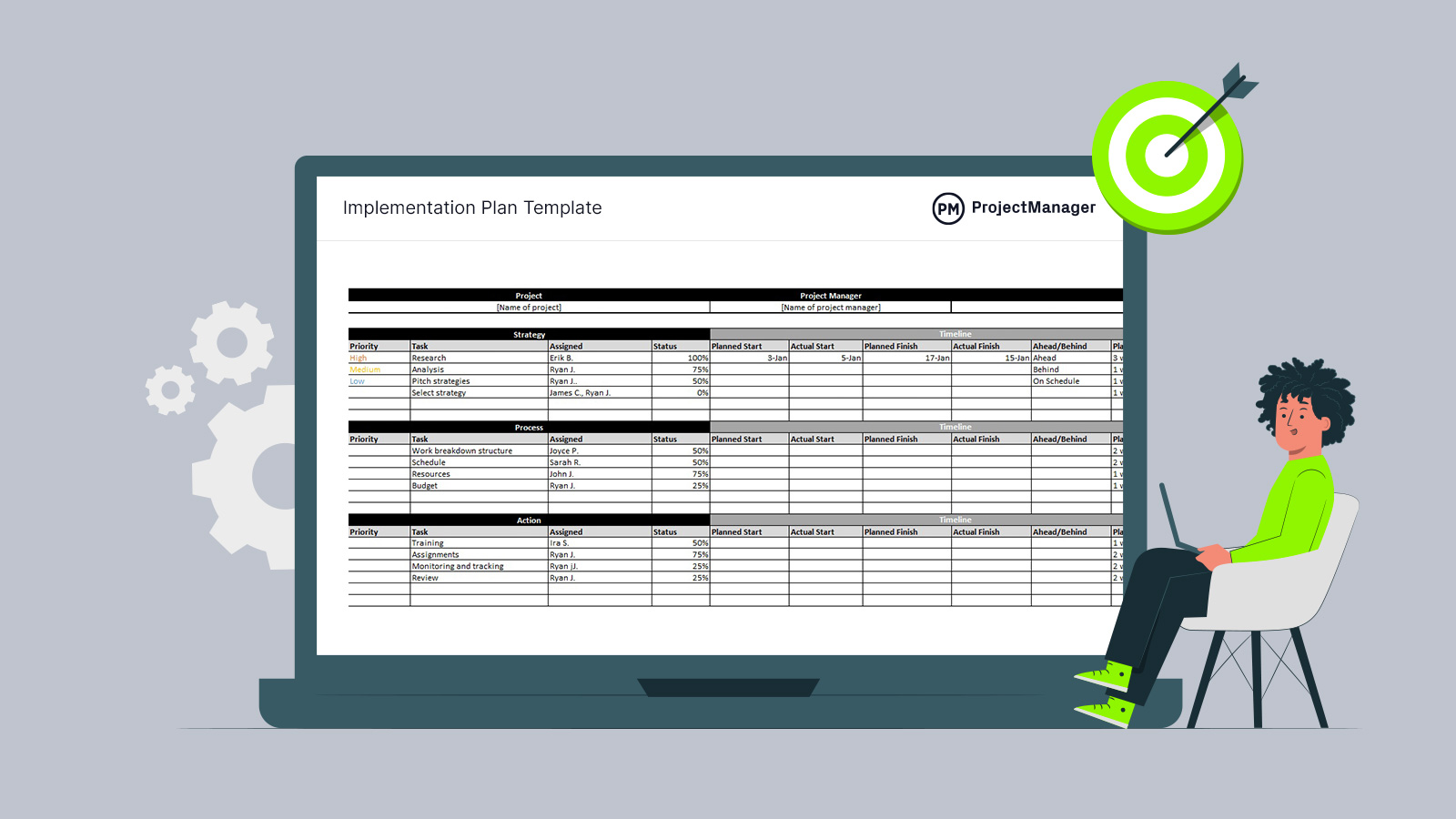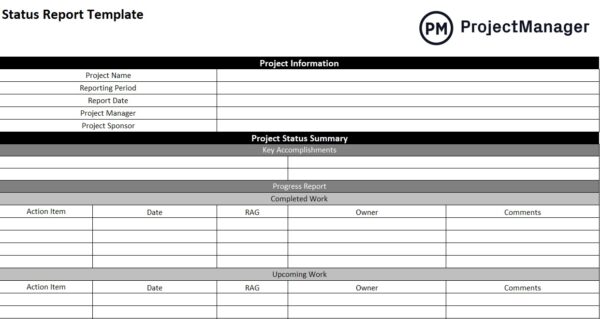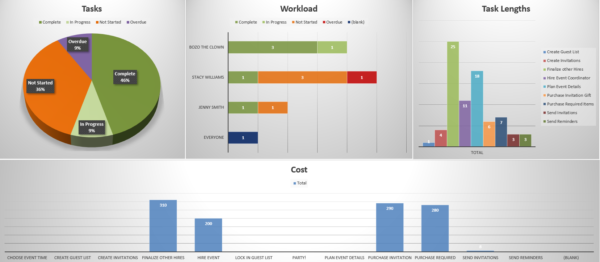
ProjectManager
by William Malsam | May 11, 2023Project implementation, or project execution, is the process of completing tasks to deliver a project successfully. These tasks are initially described in the project plan, a comprehensive document that covers all areas of project management. However, a secondary action plan, known as an implementation plan, should be created to help team members and project managers better execute and track the project.
An implementation plan is a document that describes the necessary steps for the execution of a project. Implementation plans break down the project implementation process by defining the timeline, the teams and the resources that’ll be needed.

Use this free Implementation Plan Template for Excel to manage your projects better.
Download Excel File
A project plan is a comprehensive project management document that should describe everything about your project including the project schedule, project budget, scope management plan, risk management plan, stakeholder management plan and other important components. An implementation plan, on the other hand, is a simplified version of your project plan that includes only the information that’s needed by the team members who will actually participate in the project execution phase, such as their roles, responsibilities, daily tasks and deadlines.
Project management software like ProjectManager greatly simplifies the implementation planning process. Schedule and execute your implementation plan with our robust online Gantt charts. Assign work, link dependencies and track progress in real time with one chart. Plus, if your team wants to work with something other than a Gantt chart, our software offers four other project views for managing work: task lists, kanban boards, calendars and sheets. Try it for free today.

Here are some of the key steps that you must oversee as a project manager during the project execution phase. Your project implementation plan should have the necessary components to help you achieve these steps.
Once you’ve outlined the project goals and objectives, the next step is to ensure that the team understands them. For the project to succeed, there must be buy-in from the project team. A meeting is a good way to communicate this, though having project documents that they can refer to is also viable.
The project manager will define the roles and responsibilities and communicate them to the project team. They should understand what they’re expected to do and who they can reach out to with questions about their work, all of which leads to a smooth-running project.
The project deliverables need to meet quality standards, and to do this there must be a success criteria for handing off these deliverables. You want to have something in place to determine if the deliverable is what it’s supposed to be. The measurement is called a success criteria and it applies to any deliverable, whether it’s tangible or intangible.
All projects require a schedule, which at its most basic is a start date and an end date for your project. In between those two points, you’ll have phases and tasks, which also have start and finish dates. To manage these deadlines, use a project timeline to visually map everything in one place.
Use this implementation plan template for Excel to define your strategy, scope, resource plan, timeline and more. It’s the ideal way to begin your implementation process. Download your template today.

To make sure that you’re keeping to your schedule and budget, you need to keep a close eye on the project during the execution phase. Some of the things you should monitor are your costs, time and performance. Costs refer to your budget, time refers to your schedule and performance impacts both as well as quality. By keeping track of these metrics, you can make adjustments to stay on schedule and on budget.
While the project manager is monitoring the project, the stakeholders, who have a vested interest in the project, are also going to want to stay informed. To manage their expectations and show them that the project is hitting all its milestones, you’ll want to have project reports, such as project status reports. These can then be presented to the stakeholders regularly to keep them updated.

There’s no standard one-size-fits-all solution when it comes to creating your implementation plan. However, we’ve created an implementation plan outline for your projects. Here are its components.

Follow these steps to create an implementation plan for your project or business. You can also consider using project management software like ProjectManager to help you with the implementation process.
Start by identifying what you’ll need for the execution of your implementation plan:
By interviewing stakeholders, key partners, customers and team members, you can determine the most crucial assignments needed and prioritize them accordingly. It’s also at this stage that you should list out all the goals you’re looking to achieve to cross-embed the strategic plan with the implementation plan. Everything must tie back to that strategic plan in order for your implementation plan to work.
This acts as an extension to the research and discovery phase, but it’s also important to point out assumptions and risks in your implementation plan. This can include anything that might affect the execution of the implementation plan, such as paid time off or holidays you didn’t factor into your timeline, budget constraints, losing personnel, market instability or even tools that require repair before your implementation can commence.

Each activity in your implementation plan must include a primary task owner or champion to be the owner of it. For tasks to be properly assigned, this champion will need to do the delegating. This means that they ensure that all systems are working as per usual, keep track of their teams’ productivity and more. Project planning software is practically essential for this aspect.
Next, you need to finalize all the little activities to round out your plan. Start by asking yourself the following questions:
Once all activities are outlined, all resources are listed and all stakeholders have approved (but no actions have been taken just yet), you can consider your implementation plan complete and ready for execution.
Implementation plans are used by companies across industries on a daily basis. Here’s a simple project implementation plan example we’ve created using ProjectManager to help you better understand how implementation plans work. Let’s imagine a software development team is creating a new app.

The implementation plan plays a large role in the success of your overall strategic plan. But more than that, communicating both your strategic plan and the implementation of it therein to your team members helps them feel as if they have a sense of ownership within the company’s long-term direction.
An implementation plan that’s well communicated also helps to increase cooperation across all teams through all the steps of the implementation process. It’s easy to work in a silo—you know exactly what your daily process is and how to execute it. But reaching across the aisle and making sure your team is aligned on the project goals that you’re also trying to meet? That’s another story entirely. With an implementation plan in place, it helps to bridge the divide just a little easier.
Additionally, with an implementation plan that’s thoroughly researched and well-defined, you can ensure buy-in from stakeholders and key partners involved in the project. And no matter which milestone you’re at, you can continue to get that buy-in time and time again with proper documentation.
At the end of the day, the biggest benefit of an implementation plan is that it makes it that much easier for the company to meet its long-term goals. When everyone across all teams knows exactly what you want to accomplish and how to do it, it’s easy to make it happen.
There’s more to know about implementation plans. It’s a big subject and we’ve tried to be thorough as possible, but if you have any further questions, hopefully we’ve answered them below.
The main difference between an action plan and an implementation plan is that an action plan focuses exclusively on describing work packages and tasks, while the implementation plan is more holistic and addresses other variables that affect the implementation process such as risks, resources and team roles & responsibilities.
A business implementation plan is the set of steps that a company follows to execute its strategic plan and achieve all the business goals that are described there.
Implementation plans have many uses in project management. They’re a planning tool that allows project managers to control smaller projects within their project plan. For example, they might need an implementation plan to execute risk mitigation actions, change requests or produce specific deliverables.
Creating and managing an implementation plan is a huge responsibility and one that requires diligence, patience and great organizational skills.
When it comes to a project implementation plan, there are many ways to make one that’s best suited for your team. With ProjectManager, you get access to both agile and waterfall planning so you can plan in sprints for large or small projects, track issues and collaborate easily. Try kanban boards for managing backlogs or for making workflows in departments.

Switching up the activities after a milestone meeting with stakeholders? You can easily update your implementation plan with our software features. Add new tasks, set due dates, and track how far along your team is on their current activities.
Implementation plans are the backbone of an organization’s strategic overall plan. With ProjectManager, give your organization the project management software they need to gain insight into all resources needed, view activities on their lists and collaborate with ease. Sign up for our free 30-day trial today.